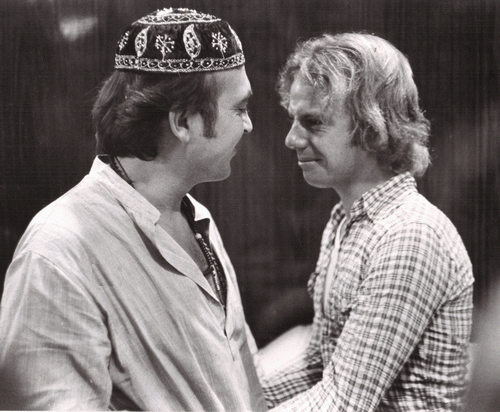The Life of Understanding Series
(The Way of Understanding)
Table of Contents
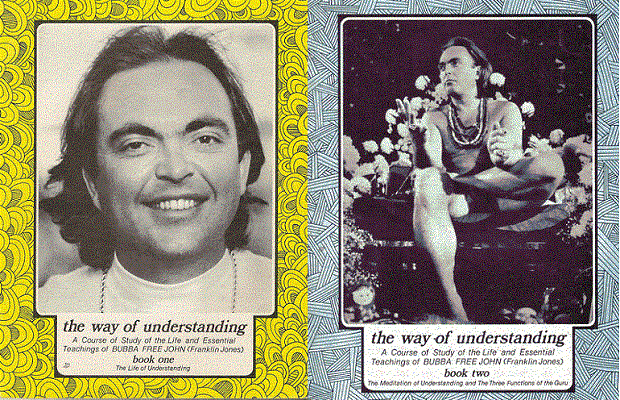
Lessons on the Knee of Listening
A twelve week course taught by Franklin Jones
January-April/May 1973
The Knee Of Listening Tapes/transcribed discourses entitled the ‘Life of Understanding’ took place in Los Angeles in 1973. The following is from an early (and present) devotee, Tom Riley about the classes held.
“The classes were held from January – April or so, 1973. I was fortunate to have been part of a small group invited by Beloved up to His Home at 2509 Thames Place, Laurel Canyon, Hollywood, CA atop the Hollywood Hills. (In hindsight and thus appropriately enough, that particular section, where Beloved Resided, atop these Laurel Canyon Hills was formally named Mt. Olympus).
He was not present physically at His Ashram on Melrose Ave. and we implemented, for the first time, some basic life disciplines as per his instructions to us during these every – Wednesday Night Sittings – Silent Satsang, Life Discipline Instruction and The audio taped Knee Of Listening Elaboration/Discourses.
The blessings, instruction and fruits of our formal spiritually – intimate time with Beloved (still Franklin Jones at this time) were communicated and brought into the general community of devotees by those of us in weekly attendance with Beloved in the living room of His Home.
Each and every Wednesday evening for approximately 12 consecutive we would arrive at 7:00 p.m. sharp. Each Wednesday evening with Him consisted of Sitting In Silence with Beloved, for approximately one hour. Beloved would then instruct us on some fundamentals of Right Life Disciplines including diet, hygiene, etc. He discoursed and elaborated (the one and only time He’s ever done this w/The Knee of Listening to my knowledge) on The Knee Of Listening; His Early Life Spiritual Autobiography. The handful of us would arrive at 7:00 p.m. and leave His Residence generally somewhere between midnight and 2:00 a.m. All of this took place between January of 1973 and into April or so of same year prior to His Pilgrimage to India in August 1973,returning to The Melrose Ashram as Bubba Free John in September 1973.”
Table of Contents
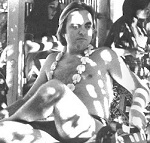
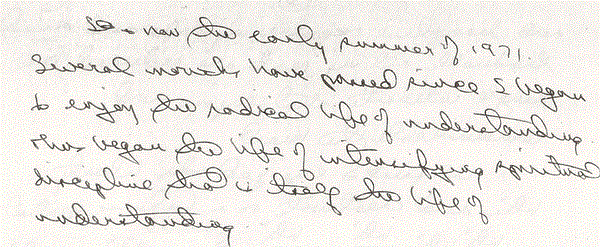
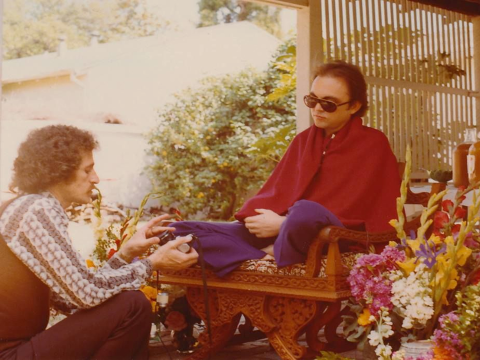
The beginning of the book is not page nine, beginning the Life of Understanding, a biographical section, the beginning of the book is the prologue, the Heart of Understanding, And this prologue contains a thesis and a claim, which is the central proposition of the entire book, And that’s why it’s here, So it would be appropriate to read it,
“Death is utterly acceptable to consciousness and life.”
This is a thesis and a claim. An unusual one, How could death be acceptable to life? It seems to be the opposite to life. How could it be acceptable to consciousness. It seems to contradict consciousness, So this is an unusual claim, a paradoxical claim. Death is utterly acceptable to consciousness and life, >>>
I was at Columbia from 1957 to 61. And by the time I got there, this complication created by the undermining of this enjoyment by the usual and traditional ways of life was full of at a critical stage. And I no longer had any resorts, no longer had any simple ability to turn to this prior condition. There was no way to turn to it without utterly living through and transforming the ordinary vehicles of life. There was no faith, no simple belief, no simple openness, relaxation, nothing available at this point. And the years when I was at Columbia, although there were dramatic years, which a great deal of work was done, where, you know, from a human point of view, very difficult mentally desperate time.>>>
Tonight I have a very long portion of the book to talk about, pages 39-83, which covers the whole period from my meeting with Rudi, all the way through all the years I was with Rudi, including going to seminary, and then going to India to Muktananda’s Ashram and then coming back. It represents about 4 years.
Most significant about this transition is that it was from this point on that I began to do sadhana in the body, in the form of the body, in the conditions of psycho-physical life, whereas previous to this my life condition had been sort of secondary. My sadhana did not involve conforming to the limitations of the body and trying to transform the life and mind; rather I was involved first of all in exploiting life and mind, and then simply in acts of attention, extreme inwardness in relation to life and mind and what is prior to life and mind.>>>
Now I said last week how, after the return in 1968 from this first trip to Muktananda’s Ashram, how another circle, another cycle of sadhana began again. This time from a totally new point of view. So there was at first the return of the old desires and tendencies, whatever. And then for a few months, really less than a year, I was involved with Scientology.>>>
So let’s go over some of this material on the Meditation of Understanding. I describe here on page 165, I give a kind of diagram of the process that occurred in every case where I was involved in exploring some aspect of the problem of existence through some method or other, approaching consciousness through the problem of mind, whatever. I would go through some adventure of some sort and the end result in every case, of each particular form of the spiritual adventure I went through, was what I called understanding. I arrived at the same thing in every case. As I went through a particular form of the problem of existence, this led to concentration and observation, then insight, then freedom, then recognition of understanding as prior to the search.>>>
“Until understanding becomes a radical activity, it simply involves the observation of experience itself appearing as levels of being, bodies, realms, and experiences. This is not meditation.” In quotes I have it here. This is not what I truly mean by meditation. This is what goes on prior to the radical activity, the activity that is real insight and enquiry. So this process of observation, self-observation, is not meditation in the strictest sense and at this stage in one’s spiritual life, this student stage, the period of listening, “the individual need only observe and understand” or come to understand.>>>
This section to be read this week is one whole long series of paragraphs that runs from page 176 to 197, and this is an important portion of the text on meditation. It deals in a very concrete way with the event of meditation that occurs when you sit in Satsang at any one time. So it’s a technical description of the process of real meditation. “Understanding is seated in consciousness, it is conscious realization. It is not seated in dilemma or any effect. It is not seated in the unconscious or subconscious, nor does it wait upon these as if they contained the source of its true intelligence or content. Neither is it seated in the super-conscious planes or wait upon them, by excluding consciousness or what is below consciousness as if exclusive super-consciousness alone were the center and source of its only mind. It (understanding) is reality functioning on a level of consciousness or the conscious mind, which is the focal point or medium of what is above and below.”>>>
So starting with this section that begins in the middle of the page on page 187, “The enquiry doesn’t produce an instant result simply because it is used.” It’s not there to produce a result to begin with. I mean it’s not a method, like a remedy and when you say it you start feeling moisture in your ears or something. But some people look for that. They’ve had an experience related to the rise of enquiry or related to the awakening of understanding in them and so they look for some sort of opening, release, psychological effect, physical change, psycho-physical change of some sort to be related to the use of enquiry. When they enquire, they look for whatever peculiar disturbance they are involved with in enquiry at the time to disappear, because they are asking this question, and then if it doesn’t happen, they begin to get involved in aggravation over it or they think there is some mystery or some dilemma involved with the fact that it’s not going away and as a matter of fact, at that point they are no longer enquiring; they’re using this verbal enquiry. But they’re not doing the thing that I’ve called enquiry, which is simply an extension of understanding itself. At that point when they are getting disturbed by the fact that things are not disappearing, they are not enquiring of the quality of avoidance that is really primarily operative at that moment. They’re looking at something else. This something else is being held in place by the thing that they have not enquired of at that moment. The thing that they are forgetting to enquire of because they are obsessed with the thing they are waiting to disappear.>>>
The first night we came together here I quoted that (that verse from) particular verse from the Bagavad Gita, in which it says the life force should be resolved in the sahasrar and the mind resolved in the Heart. The epitome of the conscious activity, the ultimate event of the conscious activity is the resolution of the consciousness in the Heart, prior to thought, prior to the reflections in the mind, prior to experience, the very Self. This is the source or reality of consciousness.>>>
So tonight I want to talk about the activity of the Guru, the Guru as Spiritual Master, the Man of Understanding as Spiritual Master. It’s very short, I’ll read to you the paragraphs and comment on them to you. Beginning near the top of page 262. “Unqualified existence, conscious as bliss, appears in the Heart and arises as love, which is the Amrita Nadi, the ‘Bright.’” I’m speaking here of love as the Amrita Nadi, love being its quality. “Love is the original, creative impulse. It is the generative source and primary form of all creativity, all manifestation. The Man of Understanding arises as love, mad with love. He is not Narcissus. Creativity is love. The world is love.” Narcissus is avoidance, separation, non-love, contraction. The Man of Understanding who has destroyed Narcissus, transcended him, obviated him, is what Narcissus is not, which is continuousness, the force of reality unobstructed, which is love.>>>
Tonight I want to talk to you about the last essay in the Wisdom of Understanding section it goes from page 266 to 268.
As I said, the portion of the book they went over last week dealt with the Guru as the spiritual master, about the true function of Satsang as the mere presence of the Guru as the principle of Satsang or spiritual life. This week we talk about the Guru s the divine form.
Guru as God is not the human individual, ego, magnifying itself dramatically to itself and thinking it is God exclusively over everyone else and having all kinds of qualities that it sort of owns. That sort of confession of divinity is insanity.>>>
Doing this last section of the book called “The Man of Understanding.” Now, in the previous two weeks we’ve spoken of the Guru in two important aspects, two of his important functions. The one is the Guru as the Spiritual Master, which you spoke of the first week, and the next time we spoke of the Guru as the Divine Form, the Divine activity, Divine presence in the world and above the world, and this week we’re talking about the Man of Understanding or the Guru as a man in the world. Now the first three sentences talk about what the man of understanding is not. The man of understanding here is both the one who happens to be writing this text and any individual who has fully realized the process of understanding, so this is a general description of anyone who meets all of the qualifications of this process. Just as the first week we spoke of the Guru as Spiritual Master, that’s true of anyone who has fully qualified to perform that function. And the second time we spoke of the Guru as the Divine Form. That’s a general description of any Siddha who has fulfilled the way of understanding. And the Man of Understanding is a general description of any such individual who has fulfilled the life of understanding. This is his appearance, his quality in the world. The one who is writing it is just animating this point of view, this principle.>>>
Read about this series and more with an interview with Tom Riley
